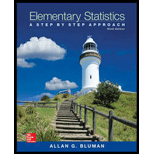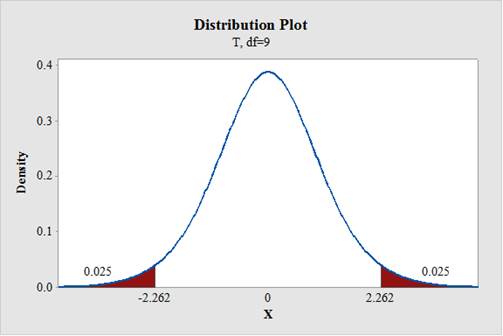
Air Quality
As a researcher for the EPA, you have been asked to determine if the air quality in the United States has changed over the past 2 years. You select a random sample of 10 metropolitan areas and find the number of days each year that the areas failed to meet acceptable air quality standards. The data are shown.

Source: The World Almanac and Book of Facts.
Based on the data, answer the following questions.
1. What is the purpose of the study?
2. Are the samples independent or dependent?
3. What hypotheses would you use?
4. What is (are) the critical value(s) that you would use?
5. What statistical test would you use?
6. How many degrees of freedom are there?
7. What is your conclusion?
8. Could an independent means test have been used?
9. Do you think this was a good way to answer the original question?
1.
To find: The purpose of the study.
Explanation of Solution
The purpose of the givens study is “to determine if the air quality in the United States has changed over the past 2 years”.
2.
To classify: The samples as independent or dependent.
Answer to Problem 1AC
The samples are dependent.
Explanation of Solution
Independent samples:
If the sample values from one population do not associate with the sample values from other population, then the two samples are said to be independent samples.
Dependent samples:
If the sample values from one population associated or matched with the sample values from other population, then the two samples are said to be dependent samples.
Matched pair design occurred at two situations, which are listed below:
- Subjects are matched with pairs and each treatment is given to one subject in each pair.
- Before and after observations on the same subjects.
Here, the samples are dependent because same metropolitan areas are taken and the samples that are related. Thus, it can be concluded that the samples are dependent.
3.
To find: The hypotheses of the study.
Answer to Problem 1AC
Hypotheses:
Null hypothesis:
Alternative hypothesis:
Explanation of Solution
Null hypothesis:
Null hypothesis is a statement about population parameter, its value is equal to the claim value, which is denoted by
Alternative hypothesis:
It is complementary to the null hypothesis. That is, it differs from the null hypothesis. The possible symbols used in the alternative hypothesis would be <,>, or ≠. It is denoted by
State the null and alternative hypotheses:
Null hypothesis:
Alternative hypothesis:
4.
To find: The critical value.
Answer to Problem 1AC
The critical value is ±2.262.
Explanation of Solution
Calculation:
Degrees of freedom:
Software Procedure:
Step-by-step procedure to obtain the critical value using the MINITAB software:
- Choose Graph > Probability Distribution Plot choose View Probability> OK.
- From Distribution, choose ‘t’ distribution.
- In Degrees of freedom, enter 9.
- Click the Shaded Area tab.
- Choose Probability value and Both Tail for the region of the curve to shade.
- Enter the Probability value as 0.05.
- Click OK.
Output using the MINITAB software is given below:

From the output, the critical value is ±2.262.
5.
To find: The statistical test.
Answer to Problem 1AC
The t test for dependent samples can be used.
Explanation of Solution
Here, the samples are dependent because same metropolitan areas are taken and the samples that are related.
Thus, the t test for dependent samples can be used.
6.
To find: The degrees of freedom.
Answer to Problem 1AC
The degrees of freedom is 9.
Explanation of Solution
Calculation:
Degrees of freedom:
Thus, the degrees of freedom is 9.
7.
To describe: The conclusion.
Answer to Problem 1AC
The conclusion is that there is no enough evidence to support the claim that the air quality in the United States has changed over the past 2 years.
Explanation of Solution
Calculation:
Software Procedure:
Step-by-step procedure to obtain the test value using the MINITAB software:
- Choose Stat > Basic Statistics > 1-Sample t.
- In Samples in Column, enter the column of Difference.
- In Perform hypothesis test, enter the test mean as 0.
- Check Options; enter Confidence level as 95%.
- Choose not equal in alternative.
- Click OK.
Output using the MINITAB software is given below:

From the output, the test value is –1.88.
Decision:
Decision rule:
If
If
Here, the value of test statistic is greater than the critical value.
That is,
Therefore, the null hypothesis is not rejected,
Thus, the decision is “fail to reject the null hypothesis”.
Hence, there is no enough evidence to support the claim that the air quality in the United States has changed over the past 2 years.
8.
To check: Whether the independent test can be used.
Answer to Problem 1AC
The independent means test cannot be used.
Explanation of Solution
Here, each metropolitan area had two readings. That is, the samples are related. Thus, the independent means test cannot be used.
9.
To describe: The result.
Explanation of Solution
Answer will vary. One of the possible answers is given below:
The answer is that there are other measures of air quality in the U.S that could have examined to answer the original question.
Want to see more full solutions like this?
Chapter 9 Solutions
Elementary Statistics: A Step By Step Approach
- 2. [20] Let {X1,..., Xn} be a random sample from Ber(p), where p = (0, 1). Consider two estimators of the parameter p: 1 p=X_and_p= n+2 (x+1). For each of p and p, find the bias and MSE.arrow_forward1. [20] The joint PDF of RVs X and Y is given by xe-(z+y), r>0, y > 0, fx,y(x, y) = 0, otherwise. (a) Find P(0X≤1, 1arrow_forward4. [20] Let {X1,..., X} be a random sample from a continuous distribution with PDF f(x; 0) = { Axe 5 0, x > 0, otherwise. where > 0 is an unknown parameter. Let {x1,...,xn} be an observed sample. (a) Find the value of c in the PDF. (b) Find the likelihood function of 0. (c) Find the MLE, Ô, of 0. (d) Find the bias and MSE of 0.arrow_forward3. [20] Let {X1,..., Xn} be a random sample from a binomial distribution Bin(30, p), where p (0, 1) is unknown. Let {x1,...,xn} be an observed sample. (a) Find the likelihood function of p. (b) Find the MLE, p, of p. (c) Find the bias and MSE of p.arrow_forwardGiven the sample space: ΩΞ = {a,b,c,d,e,f} and events: {a,b,e,f} A = {a, b, c, d}, B = {c, d, e, f}, and C = {a, b, e, f} For parts a-c: determine the outcomes in each of the provided sets. Use proper set notation. a. (ACB) C (AN (BUC) C) U (AN (BUC)) AC UBC UCC b. C. d. If the outcomes in 2 are equally likely, calculate P(AN BNC).arrow_forwardSuppose a sample of O-rings was obtained and the wall thickness (in inches) of each was recorded. Use a normal probability plot to assess whether the sample data could have come from a population that is normally distributed. Click here to view the table of critical values for normal probability plots. Click here to view page 1 of the standard normal distribution table. Click here to view page 2 of the standard normal distribution table. 0.191 0.186 0.201 0.2005 0.203 0.210 0.234 0.248 0.260 0.273 0.281 0.290 0.305 0.310 0.308 0.311 Using the correlation coefficient of the normal probability plot, is it reasonable to conclude that the population is normally distributed? Select the correct choice below and fill in the answer boxes within your choice. (Round to three decimal places as needed.) ○ A. Yes. The correlation between the expected z-scores and the observed data, , exceeds the critical value, . Therefore, it is reasonable to conclude that the data come from a normal population. ○…arrow_forwardding question ypothesis at a=0.01 and at a = 37. Consider the following hypotheses: 20 Ho: μ=12 HA: μ12 Find the p-value for this hypothesis test based on the following sample information. a. x=11; s= 3.2; n = 36 b. x = 13; s=3.2; n = 36 C. c. d. x = 11; s= 2.8; n=36 x = 11; s= 2.8; n = 49arrow_forward13. A pharmaceutical company has developed a new drug for depression. There is a concern, however, that the drug also raises the blood pressure of its users. A researcher wants to conduct a test to validate this claim. Would the manager of the pharmaceutical company be more concerned about a Type I error or a Type II error? Explain.arrow_forwardFind the z score that corresponds to the given area 30% below z.arrow_forwardFind the following probability P(z<-.24)arrow_forward3. Explain why the following statements are not correct. a. "With my methodological approach, I can reduce the Type I error with the given sample information without changing the Type II error." b. "I have already decided how much of the Type I error I am going to allow. A bigger sample will not change either the Type I or Type II error." C. "I can reduce the Type II error by making it difficult to reject the null hypothesis." d. "By making it easy to reject the null hypothesis, I am reducing the Type I error."arrow_forwardGiven the following sample data values: 7, 12, 15, 9, 15, 13, 12, 10, 18,12 Find the following: a) Σ x= b) x² = c) x = n d) Median = e) Midrange x = (Enter a whole number) (Enter a whole number) (use one decimal place accuracy) (use one decimal place accuracy) (use one decimal place accuracy) f) the range= g) the variance, s² (Enter a whole number) f) Standard Deviation, s = (use one decimal place accuracy) Use the formula s² ·Σx² -(x)² n(n-1) nΣ x²-(x)² 2 Use the formula s = n(n-1) (use one decimal place accuracy)arrow_forwardarrow_back_iosSEE MORE QUESTIONSarrow_forward_ios
 Holt Mcdougal Larson Pre-algebra: Student Edition...AlgebraISBN:9780547587776Author:HOLT MCDOUGALPublisher:HOLT MCDOUGAL
Holt Mcdougal Larson Pre-algebra: Student Edition...AlgebraISBN:9780547587776Author:HOLT MCDOUGALPublisher:HOLT MCDOUGAL Glencoe Algebra 1, Student Edition, 9780079039897...AlgebraISBN:9780079039897Author:CarterPublisher:McGraw Hill
Glencoe Algebra 1, Student Edition, 9780079039897...AlgebraISBN:9780079039897Author:CarterPublisher:McGraw Hill Big Ideas Math A Bridge To Success Algebra 1: Stu...AlgebraISBN:9781680331141Author:HOUGHTON MIFFLIN HARCOURTPublisher:Houghton Mifflin Harcourt
Big Ideas Math A Bridge To Success Algebra 1: Stu...AlgebraISBN:9781680331141Author:HOUGHTON MIFFLIN HARCOURTPublisher:Houghton Mifflin Harcourt


